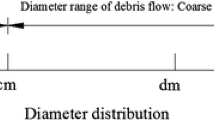Abstract
Impact of debris flow consists of two distinctive phases due to its physical composition. One is the dynamic impact from fluid phase, and the other is collision from the solid phase. At present, there is no effective way to differentiate these two phases of impact. An empirical mode decomposition (EMD)-based signal process method was proposed in this paper to extract fluid and solid impact force of debris flow from the mixed signal. Miniaturized flume tests have been carried out with 14 work conditions, and the impact signals were captured by a digital logger. From the experiment, frequencies of fluid phase and solid phase impact signals were identified in the range of 0.05–2 Hz and 300–600 Hz, respectively. The impact signals from solid and liquid phases were reconstructed using the proposed method. In addition, the impact force of fluid phase that measured directly from the flume tests and calculated from isolated signals showed good agreement and the average difference was about 10%. However, large deviation of solid phase impact was observed especially when this method was applied to the full-scale debris flow events and the difference ranged from 26.33 to 61.47%. This proposed method provided an alternative approach to study the debris flow impact force in terms of slurry and large particles separately.












Similar content being viewed by others
References
Aggag G, Takahashi K (1996) Study of oscillation signals in instrumented Charpy impact testing [J]. Polym Eng Sci 36(17):2260–2266
Armanini A, Scotton P (1993) On the dynamic impact of a debris flow on structures. [C]//proceedings of the Congress-international association for hydraulic research Local Organizing Committee Of The Xxv Congress 3: 203–203
Bartelmus W, Zimroz R (2009) A new feature for monitoring the condition of gearboxes in non-stationary operating conditions [J]. Mech Syst Signal Process 23(5):1528–1534
Chen HK, Xian XF, Tang HM et al (2011) Time-frequency analysis method of debris flow impact loads and its application [J]. J Disaster Prev Mitig Eng 31(3):255–260
Chen TC, Lin ML, Wang KL (2014) Landslide seismic signal recognition and mobility for an earthquake-induced rockslide in Tsaoling, Taiwan [J]. Eng Geol 171:31–44
Cui P, Zeng C, Lei Y (2015) Experimental analysis on the impact force of viscous debris flow [J]. Earth Surf Process Landf 40(12):1644–1655
Feng Z (2012) The seismic signatures of the surge wave from the 2009 Xiaolin landslide-dam breach in Taiwan [J]. Hydrol Process 26(9):1342–1351
Hu K, Wei F, Li Y (2011) Real-time measurement and preliminary analysis of debris-flow impact force at Jiangjia Ravine, China [J]. Earth Surf Process Landf 36(9):1268–1278
Huang NE, Wu Z (2008) A review on Hilbert-Huang transform: method and its applications to geophysical studies. Rev Geophys 46(2). doi:10.1029/2007RG000228
Huang NE, Shen Z, Long SR et al (1998) The empirical mode decomposition and the Hilbert spectrum for nonlinear and non-stationary time series analysis. Proceedings of the Royal Society of London A: mathematical, physical and engineering sciences 454(1971):903–995
Hübl J, Holzinger G (2003) Entwicklung von Grundlagen zur Dimensionierung kronenoffener Bauwerke für die Geschiebebewirtschaftung in Wildbächen: Kleinmaßstäbliche Modellversuche zur Wirkung von Murbrechern [J]. WLS Rep 50
Huebl J, Jaeger G (2004) Real scale debris flow experiments, at Gaschiera/A.Nice France: European Geosciences Union
Ishikawa N, Inoue R, Hayashi K, et al (2008) Experimental approach on measurement of impulsive fluid force using debris flow model[M]. na
Itakura Y, Suwa H, Takeuchi M (2009) Measurement of surface velocity of debris flows by spatial filtering velocimetry. Transactions of the Society of Instrument and Control Engineers 25(4):504–506
Iverson RM (1997) The physics of debris flows [J]. Rev Geophys 35(3):245–296
Liu J, Wei H (1997) Study of impact of debris flow [J]. J Sichuan Univ (Eng Sci Ed) 1(2):99–102
Lundquist JK (2003) Intermittent and elliptical inertial oscillations in the atmospheric boundary layer [J]. J Atmos Sci 60(21):2661–2673
Srinivasan R, Rengaswamy R, Miller R (2007) A modified empirical mode decomposition (EMD) process for oscillation characterization in control loops [J]. Control Eng Pract 15(9):1135–1148
Suwa H, Okunishi K, Sakai M (1993) Motion, debris size and scale of debris flows in a valley on mount Yakedake, Japan [J]
Tang J, Hu K, Zhou G (2013) Debris flow impact pressure signal processing by the wavelet analysis [J]. J Sichuan Univ (Eng Sci Ed) 1:8–13
Vasudevan K, Cook FA (2000) Empirical mode skeletonization of deep crustal seismic data: theory and applications. J Geophys Res 105:7845–7856. doi:10.1029/1999JB900445
Visual Signal, Copyright 2011 AnCAD, Inc
Wendeler C, Volkwein A, Roth A, et al (2007) Field measurements and numerical modelling of flexible debris flow barriers [J]. Debris-Flow Hazards Mitig. Mech. Predict. Assess. Millpress, Rotterdam, 681–687
Wu W, Peng H (2014) Application of EMD denoising approach in noisy blind source separation [J]. J Commun 9(6)
Zeng C, Su Z, Lei Y (2015) An experimental study of the characteristics of impact forces between debris flow slurry and large-sized particles [J]. Rock Soil Mech 36(7):1923–1930
Zhang SC (1993) A comprehensive approach to the observation and prevention of debris flows in China. Nat Hazards 7(1):1–23
Acknowledgements
This work is supported by the Major International (Regional) Joint Research Project (Grant No. 41520104002) from the National Natural Science Foundation of China, National Key Technology Support Program (Grant No. 2014BAL05B01), and Sichuan Technology Support Program (Grant No. 2014SZ0163).
Author information
Authors and Affiliations
Corresponding author
Rights and permissions
About this article
Cite this article
Lei, Y., Cui, P., Zeng, C. et al. An empirical mode decomposition-based signal process method for two-phase debris flow impact. Landslides 15, 297–307 (2018). https://doi.org/10.1007/s10346-017-0864-1
Received:
Accepted:
Published:
Issue Date:
DOI: https://doi.org/10.1007/s10346-017-0864-1




